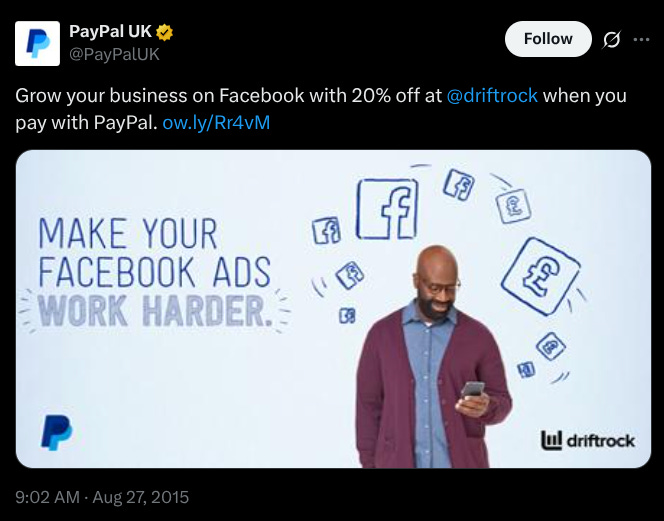How to Get Partners to Partner With Partners
Every platform partner has one thing in common - you.
Often, the typical motion of a typical platform partnerships team looks something like this: win partners, onboard them, manage relationships, track metrics, keep iterating.
But for “market maker” platforms in particular, there’s an even bigger opportunity.
If you're running partnerships for a "market maker" platform (think Meta, Salesforce, Shopify, Atlassian), you also have a duty to orchestrate connections between partners.
Every partner has, after all, one thing in common - you.
Connecting partners with other partners creates a flywheel-velocity web of value that benefits them, your customers, and company. It can be a huge force multiplier.
Example: PayPal + Facebook + Marketing Partners
Back in 2015, when I was on the Marketing API partnerships team at Facebook, PayPal came to me with what sounded like a straightforward ask: they wanted to grow transaction volume (and average order value) for 2 million SMB merchants in the UK.
Their initial “ask” was pretty obvious: we (Facebook) should help them build their own ad buying tool, so their merchants could run ads via PayPal.
I pushed back.
AdTech wasn’t PayPal's core competency (at least not then). They were a payments company, and in the midst of being spun out of eBay. I knew from experience they’d have an incredibly hard time securing product and engineering resources internally.
My question to them: why reinvent the AdTech wheel when we already had dozens of Facebook Marketing Partners who’d already perfected their SMB marketing tools?
I suggested a lower-friction, faster-moving option: I’d help orchestrate partnerships between PayPal and three existing partners: AdEspresso, Driftrock, and Kit.
The structure was pretty simple:
Each partner would create a compelling offer for PayPal’s merchants (example: 50% off for 3 months)
PayPal would, in turn, promote these offers to their 2 million UK merchants, through emails, paid ads, and social media posts
Facebook would also allocate advertising credits to incentivize customers to try each partner tool, and to try PayPal as a new way to pay for their ads
We launched it within weeks, not months.
It was a win-win-win all round. Partners acquired new customers, PayPal drove transaction volume, and Facebook activated new advertisers. Most importantly, customers learned how to promote their products and services on Facebook.
A framework you can apply
This approach works well for almost any partnership scenario or partner type: technology partners, solutions partners, GSIs, SIs, affiliates, and more.
Start with these steps:
1. Create a partner value map
First, understand the unique value each partner brings and what they need in return. PayPal brought distribution and needed marketing tools for their customers. Our Marketing Partners had marketing tools and needed distribution.
It was an obvious match, once we mapped it out.
2. Design win-win-win structures
Every partner needs to “win” in these scenarios: Partner A, Partner B, and the platform. Without mutual and meaningful value exchange, the system breaks.
3. Provide air cover and incentives
Partners often won’t organically collaborate - they’re busy building their own businesses. And they often don’t trust other partners. You need to build that trust for them, whilst removing friction and adding motivation.
Facebook ad credits were a crucial component of the PayPal partnership - if we had “skin in the game” it was easier for other partners to trust the process and commit.
4. Think big, start small
Start with small pilot programs that involve a handful of partners: 3-5 usually creates enough incentives and value-mix. If I’d tried to co-ordinate 10+ partners in the PayPal example, it would likely have failed miserably. Prove the model works first.
5. Measuring Success Beyond Revenue
In the PayPal example, of course we tracked traditional metrics like revenue, customer acquisition, and retention, but we also measured relationship health:
Partner integration rates: which partners were actively working together?
Customer satisfaction: Are customers getting value from each partner?
Time to value: How quickly do these new partner combinations generate results?
In platform ecosystems, everyone can win
The best platform partnerships teams don’t just manage relationships - they architect connections between every player and partner in the ecosystem. When you successfully get partners to partner with other partners, you’re not just facilitating transactions between them.
You’re generating case studies, playbooks, examples - gravitational pull - that creates value, attracts more partners, and builds defensible moats around your platform.
Your partners should be partners, too. It’s your job to help them discover each other.
If you enjoyed reading this post - or would like to ask me a question - comment below or reach out to me on LinkedIn.



